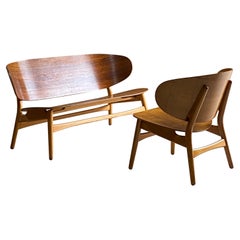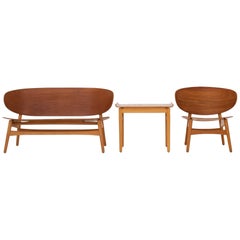Fh 1935
Recent Sales
Vintage 1950s Danish Mid-Century Modern Settees
Teak, Beech
Mid-20th Century Danish Scandinavian Modern Living Room Sets
Teak
Fritz Hansen for sale on 1stDibs
When the Copenhagen-based furniture maker Fritz Hansen opened for business more than 140 years ago, the company — which today styles itself The Republic of Fritz Hansen — adhered to the traditional, time-honored Danish values of craftsmanship in woodworking and joinery. Yet thanks to the postwar innovations of Arne Jacobsen and others, Fritz Hansen would become the country’s leader in Scandinavian modern design using new, forward-looking materials and methods.
Fritz Hansen started his company in 1872, specializing in the manufacture of small furniture parts. In 1915, the firm became the first in Denmark to make chairs using steam-bent wood (a technique most familiar from birch used in the ubiquitous café chairs by Austrian maker Thonet). At the time, Fritz Hansen was best known for seating that featured curved legs and curlicue splats and referenced 18th-century Chippendale designs.
In the next few decades, the company promoted simple, plain chairs with slatted backs and cane or rush seats designed by such proto-modernist masters as Kaare Klint and Søren Hansen. Still, the most aesthetically striking piece Fritz Hansen produced in the first half of the 20th century was arguably the China chair of 1944 by Hans Wegner — and that piece, with its yoke-shaped bentwood back- and armrest, was based on seating manufactured in China during the Ming dynasty. (Wegner was moved by portraits he’d seen of Danish merchants in the Chinese chairs.)
Everything changed in 1952 with Arne Jacobsen’s Ant chair. The collaboration between the architect and Fritz Hansen officially originated in 1934 — that year, Jacobsen created his inaugural piece for the manufacturer, the solid beechwood Bellevue chair for a restaurant commission. The Ant chair, however, was the breakthrough.
With assistance from his then-apprentice Verner Panton, Jacobsen designed the Ant chair for the cafeteria of a Danish healthcare company called Novo Nordisk. The chair was composed of a seat and backrest formed from a single piece of molded plywood attached, in its original iteration, to three tubular metal legs. Its silhouette suggests the shape of the insect’s body, and the lightweight, stackable chair and its biomorphic form became an international hit.
Jacobsen followed with more plywood successes, such as the Grand Prix chair of 1957. The following year he designed the SAS Royal Hotel in Copenhagen and its furnishings, including the Egg chair and the Swan chair. Those two upholstered pieces, with their lush, organic frames made of fiberglass-reinforced polyurethane, have become the two chairs most emblematic of mid-20th-century cool. Moreover, the Egg and Swan led Fritz Hansen to fully embrace new man-made materials, like foam, plastic and steel wire used to realize the avant-garde creations of later generations of designers with whom the firm collaborated, such as Piet Hein, Jørn Utzon (the architect of the Sydney Opera House) and Verner Panton. If the Fritz Hansen of 1872 would not now recognize his company, today’s connoisseurs certainly do.
Find a collection of vintage Fritz Hansen tables, lounge chairs, sofas and other furniture on 1stDibs.
Finding the Right living-room-sets for You
Your living room — how your antique and vintage living room furniture is arranged, what style of furniture you’ve chosen, what kind of decor best suits your needs — should be an opportunity to express yourself as well as to unabashedly show off your design taste and preferences.
Common wisdom used to declare the kitchen the hub of the house. These days, the living room seems to have assumed the role of domestic focal point. Unlike the Victorian parlor, stiffly furnished and reserved for guests, today’s living room is a central place for reading and displaying your books, conversation and, well, living, with furnishings that lend themselves to both casual lounging and elegant entertaining.
A living room that doesn’t double as a family or TV room is a luxury. But even if the electronics are elsewhere, this is a hard-working, well-used space.
In an era that sees an increasing number of professionals working from home, sometimes your living room is multifunctional in ways you never thought possible. A corner of this room might be a designated home office, outfitted with a desk, your laptop and notebooks and, of course, the best possible lighting for those unscheduled Zoom calls. Perhaps you’ve sectioned off an area with side tables and armchairs for entertaining small groups while another corner of the room is home to a cozy reading nook.
The appetite for antique and vintage furniture — sculptural mid-century modern case pieces crafted in teak and other dark woods, the sexy, sensuous seating of the 1970s — has only broadened in recent years, with design lovers treasure hunting online and on Instagram.
A Scandinavian modern living room set, featuring lounge chairs and sofas by the likes of Hans Wegner or Kaare Klint, will help you introduce quality craftsmanship characterized by gentle, organic contours into your space, while a Camaleonda sofa by legendary Italian designer Mario Bellini will dazzle with its chunky form and convenient modular setup.
On 1stDibs, find an extraordinary collection of antique and vintage living room furniture inclusive of Space Age living room sets, other clever and provocative furnishings of the 1950s and ’60s, postmodern pieces and much more.

